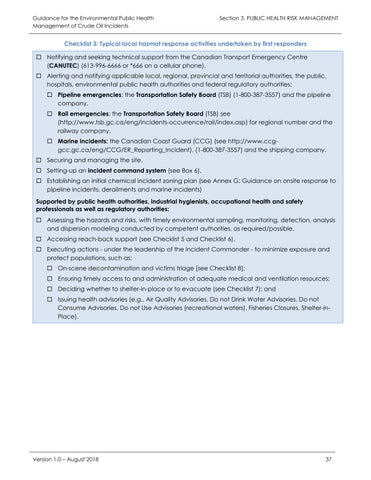Guidance for the Environmental Public Health Management of Crude Oil Incidents
Section 3. PUBLIC HEALTH RISK MANAGEMENT
Checklist 3: Typical local hazmat response activities undertaken by first responders Notifying and seeking technical support from the Canadian Transport Emergency Centre (CANUTEC) (613-996-6666 or *666 on a cellular phone). Alerting and notifying applicable local, regional, provincial and territorial authorities, the public, hospitals, environmental public health authorities and federal regulatory authorities: Pipeline emergencies: the Transportation Safety Board (TSB) (1-800-387-3557) and the pipeline company. Rail emergencies: the Transportation Safety Board (TSB) see (http://www.tsb.gc.ca/eng/incidents-occurrence/rail/index.asp) for regional number and the railway company. Marine incidents: the Canadian Coast Guard (CCG) (see http://www.ccggcc.gc.ca/eng/CCG/ER_Reporting_Incident), (1-800-387-3557) and the shipping company. Securing and managing the site. Setting-up an incident command system (see Box 6). Establishing an initial chemical incident zoning plan (see Annex G: Guidance on onsite response to pipeline incidents, derailments and marine incidents) Supported by public health authorities, industrial hygienists, occupational health and safety professionals as well as regulatory authorities: Assessing the hazards and risks, with timely environmental sampling, monitoring, detection, analysis and dispersion modeling conducted by competent authorities, as required/possible. Accessing reach-back support (see Checklist 5 and Checklist 6). Executing actions - under the leadership of the Incident Commander - to minimize exposure and protect populations, such as: On-scene decontamination and victims triage [see Checklist 8]; Ensuring timely access to and administration of adequate medical and ventilation resources; Deciding whether to shelter-in-place or to evacuate (see Checklist 7); and Issuing health advisories (e.g., Air Quality Advisories, Do not Drink Water Advisories, Do not Consume Advisories, Do not Use Advisories (recreational waters), Fisheries Closures, Shelter-inPlace).
Version 1.0 – August 2018
37







